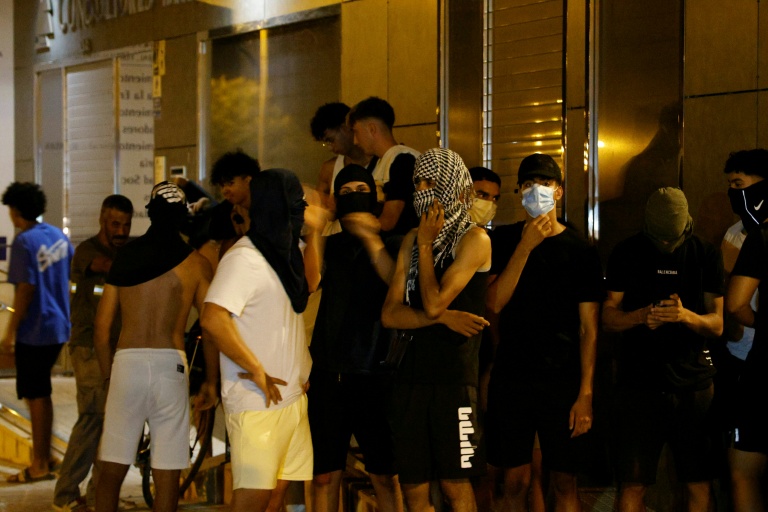Spanish Town Erupts in Anti-Migrant Violence, Fueled by Online Disinformation and Political Rhetoric
The tranquil Spanish town of Torre Pacheco, nestled in the southeastern region of Murcia, recently became the epicenter of a disturbing wave of anti-migrant violence, exposing the dangerous nexus between online disinformation, xenophobic hate speech, and political opportunism. The unrest, which pitted far-right groups against immigrant residents, primarily of Moroccan origin, served as a stark reminder of how quickly online narratives can escalate into real-world consequences. While a heavy police presence prevented the situation from spiraling into widespread bloodshed, the events left a community scarred and raised serious concerns about the growing influence of extremist ideologies.
The spark that ignited the powder keg of anti-immigrant sentiment was an alleged assault on a 68-year-old pensioner by three men of North African origin. While the veracity of the attack remained under investigation, the incident quickly became fodder for online disinformation campaigns. A video purportedly depicting the assault, alongside a list of alleged perpetrators, circulated rapidly across social media platforms, both later debunked by fact-checkers. This manipulated narrative tapped into pre-existing anxieties surrounding immigration, fueled by a steady stream of misinformation concerning public benefits supposedly enjoyed by migrants and fabricated accounts of attacks on Spanish citizens. This pre-existing climate of distrust, carefully cultivated by extremist groups, provided fertile ground for the incident to escalate into widespread unrest.
Experts in disinformation and social media analysis point to a deliberate strategy employed by these groups. Alexandre Lopez Borrull, a professor in communication and information science at the Open University of Catalonia, describes disinformation as both “the fuel and the spark” in such scenarios. The narrative, he explains, is carefully constructed and disseminated over an extended period, creating a simmering undercurrent of resentment. Then, a specific event, like the alleged assault in Torre Pacheco, acts as the catalyst, igniting the pre-existing tensions and propelling them into the public sphere.
The role of political actors, particularly the far-right Vox party, in amplifying and exploiting these narratives cannot be overstated. Vox has consistently linked immigration to crime, echoing similar rhetoric employed by far-right movements across Europe. Their recent proposal for a “remigration” plan, advocating for the deportation of certain migrants, further fuels the flames of xenophobia. In the aftermath of the Torre Pacheco unrest, Vox’s regional leader blamed “illegal immigration” for the violence, accusing migrants of assaults on the elderly and sexual violence against women. These inflammatory statements are currently under investigation by prosecutors to determine if they constitute hate crimes.
The trajectory of the disinformation campaign in Torre Pacheco followed a pattern observed in other similar incidents. Initially, the inflammatory narratives simmered within closed online communities and less visible platforms like Telegram, providing a breeding ground for extremist ideologies. These narratives then migrated to more mainstream platforms such as X (formerly Twitter) and TikTok, reaching a wider audience and further amplifying the message. Finally, political figures like those from Vox seized upon these narratives, legitimizing and disseminating them through public pronouncements, ultimately contributing to the eruption of real-world violence.
Elisa Brey, a sociology professor at Madrid’s Complutense University, offers a chilling analogy, comparing the phenomenon to arsonists exploiting dry, tinderbox conditions. “It’s hot, there’s a temperature alert, and an arsonist passes by and throws a match. That is what happens with disinformation,” she explains. The pre-existing social tensions, stoked by online misinformation, create a volatile environment ripe for exploitation. A single incident, whether real or fabricated, can then serve as the spark that ignites the flames of violence. This underscores the dangerous interplay between online and offline worlds, where virtual narratives can have devastating real-world consequences. The events in Torre Pacheco serve as a cautionary tale, highlighting the urgent need to combat disinformation and address the underlying social anxieties that fuel such eruptions of xenophobia. Furthermore, they underscore the responsibility of politicians and social media platforms to prevent the spread of hateful rhetoric and ensure that online spaces do not become breeding grounds for violence. The incident in Torre Pacheco should be a wake-up call, prompting a deeper examination of how online disinformation, fueled by political opportunism, can tear at the fabric of a community and threaten the safety and well-being of vulnerable populations.


